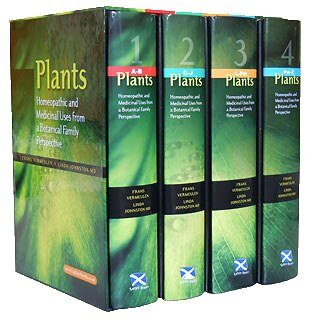Plants are the largest section in both the homeopathic materia medica and traditional medicine. The various materia medicae and repertories list over 2000 plants remedies, but the amount of information available on which to base prescriptions is sparse at best.
This major work details over 2000 individual plant remedies classified in 150 botanic families. Drawing on a wealth of information from provings, clinical observations, herbal uses, folk lore, mythology, botany, personal accounts, toxicology and other sources, the authors weave an in-depth, coherent picture of each botanic family and its members. Each family’s themes and organ system affinities are discussed, supported by the plants’ chemical composition, physiological and pharmacological effects. In addition, for each plant remedy, Plants, lists the number of rubrics in modern repertories, as well as phytochemical composition, official and common names, botanical descriptions and distribution.
Combining the clarity and detail for which Frans' work is renowned with Linda's years of clinical experience promises to deliver a definitive text on plant remedies.
About the authors
Frans Vermeulen is recognised throughout the homeopathic world as an author, lecturer and authority on materia medica. Each of the many books he has authored makes a contribution of major significance to our understanding of substances and materia medica. His lectures are inspiring and appreciated for their liveliness, depth of knowledge and breadth of factual information.
Born in Den Helder, Holland, Frans taught at an elementary school from 1970 to 1978. From 1976 – 1983 he pursued his homeopathic education, while beginning his own practice in 1979. At this time, he had begun to translate homeopathic books by masters such as Kent, Allen, Tyler, Vithoulkas, and many others. In 1985 he wrote Kindertypes in de Homoeopathie (Children types in Homoeopathy) (Sonntag, 1988), based on his experiences as both a teacher and a homeopath.
In 1992 he wrote Synoptic Materia Medica I (Emryss, 1992), providing a materia medica overview as well as a quick and compact reference. This was followed by the Concordant Materia Medica (Emryss, 1994), which was enlarged in 1997 to include Hering’s Guiding Symptoms. Synoptic Materia Medica II (Emryss, 1996) broke new ground by focusing on small remedies and the correlations between the sources of the homeopathic remedies and how they relate to the drug pictures. Furthering that theme, Prisma (Emryss, 2002) takes data from non-homoeopathic sources as both reference material for the homoeopathic materia medica and as the source of potential symptoms. Frans’ two most recent books are Kingdom Monera and Viruses (Emryss, 2005) and by Kingdom Fungi (Emryss, 2007)
Now, after five years in the making, Frans is finishing his book on Kingdom Plants. Co-authored by his wife, Dr. Linda Johnston, the book discusses over 2000 plant remedies in 149 families following the latest classification system, APG II. Family themes are elucidated based on botanical classifications, phytochemicals, botany, traditional uses, folklore, history and many other sources, further supported by homeopathic information from provings, cases and other materia medica sources.
_________
Dr Linda Johnston has been a active member of the homeopathic community worldwide since the inception of her homeopathic practice in 1986. After completing her medical training from the University of Washington, USA in 1979, she had one further year in family medicine. She started her own private medical practice in 1981. Linda began her homeopathic training in 1986, and began practicing the same year. Linda’s main focus has always been her clinical practice of homeopathy, which she continues to this day.
Contributing to the homeopathic community through writing and teaching are both important to Linda. From 1991 – 1996, she developed and taught a two-year homeopathy curriculum in 4 different US cities to train licensed medical practitioners. She is also a well-known teacher internationally.
Author of numerous articles for homeopathy journals, Linda is also the author ofAdditions to the Homeopathic Repertory from Kent’s lectures on Homeopathic Materia Medica (Christine Kent Agency, 1990) as well as a popular book for the general public, Everyday Miracles: Homeopathy in Action (Christine Kent Agency, 1991) and her most recent work The Child's World (Saltire Books, 2010 - more info here). Since her debut public lecture in 1987, she has made hundreds of radio, television appearances, in addition to print media interviews educating the public about homeopathy.
 Wishlist
Wishlist





